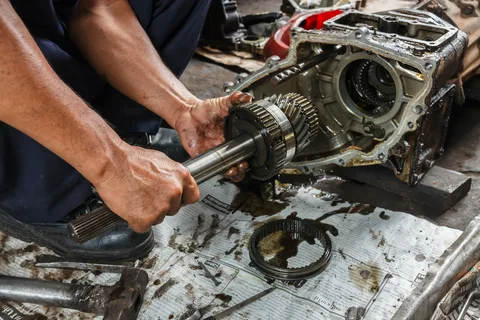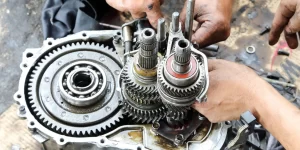If you’re having car trouble and think you might need a new transmission, hold off on buying one until you’ve checked your sawdust levels. That’s right, folks, sawdust is the key to a healthy transmission, and if you’re low on it, your car will suffer.

Why is There Sawdust in My Transmission?
Contents
If you have ever taken your car to a mechanic with a transmission problem, you may have been told that there is sawdust in your transmission. This is because the clutches in your transmission wear down over time and create small metal shavings that look like sawdust.
While this may seem like a serious problem, it is actually quite common and can be easily fixed by having your transmission rebuilt or replaced.

How Can I Get Rid of the Sawdust in My Transmission?
If you notice sawdust in your transmission, it’s important to get rid of it as soon as possible. Sawdust can cause damage to the transmission and may lead to transmission failure.
There are a few ways to get rid of the sawdust in your transmission.
- One way is to take the transmission apart and clean it with a degreaser.
- Another way is to add a transmission filter. This will help catch any debris before it has a chance to enter the transmission.
What Are the Consequences of Having Sawdust in My Transmission?
Sawdust in a car’s transmission can cause a wide variety of problems, from shifting issues to leaks and complete Transmission failure. One of the most common issues is decreased transmission fluid pressure, which can lead to slipping gears and eventual transmission failure.
In addition, sawdust can also clog filters and oil passages, leading to diminished performance and increased wear on your transmission’s internals. If you suspect that there may be sawdust in your transmission, it’s important to have it checked out by a qualified mechanic as soon as possible.
Is It Harmful to Have Sawdust in My Transmission?
Sawdust in your transmission can be harmful if it accumulated in large enough quantities. Sawdust can act as an abrasive and damage the gears and other components in your transmission. If you notice sawdust in your transmission, it’s best to have it checked by a mechanic as soon as possible.
How Can I Prevent Sawdust From Getting Into My Transmission?
Sawdust can easily get into your transmission and cause problems. The best way to prevent this is to keep your sawdust collector close to your work area and make sure that the intake hose is positioned so that it will not pick up any debris. You should also regularly check your transmission for any build-up of sawdust and clean it out if necessary.
What Should I Do if I Find Sawdust in My Transmission?
If you find sawdust in your transmission, it’s important to take immediate action to prevent further damage.
- The first step is to check the transmission fluid level and add more if needed.
- Once the fluid level is checked, the next step is to locate the source of the sawdust.
- The most likely culprit is a leak in the transmission cooler lines. To fix this, you will need to replace the transmission cooler lines.
How Do I Know if There is Sawdust in My Transmission?
If your car isn’t shifting gears properly, there could be sawdust in the transmission. Check the transmission fluid level first; if it’s low, topping it off may solve the problem. If the fluid level is fine, then check for leaks. If you see any sawdust around the seals or gaskets, then you know there’s a problem.
Can Sawdust in My Transmission Cause My Car to Break Down?
Sawdust in your transmission can cause your car to break down if it is not removed in a timely manner. The sawdust can act as an abrasive and cause wear on the gears, bearings, and other components of the transmission. If the sawdust is not removed, it can build up and eventually cause the transmission to fail.
FAQs( Frequently Asked Questions)
What Can Destroy a Transmission?
- Delay Transmission Maintenance. …
- Slam You Brakes. …
- Never Use Parking Brake. …
- Pound the Gas Pedal. …
- Don’t Stop Before Shifting from Drive to Reverse. …
- Never Check Transmission Fluid.
What Are the Signs Your Transmission is Going Out?
- Burning Smell. A burning smell says a lot about your vehicle’s safety and functioning. …
- Strange Noises When Your Car is In Neutral. …
- Trouble Switching Gears. …
- Leaking Fluid. …
- Vibrating or Shaking.
What Are the Top 5 Signs of Transmission Problems?
- Strange Smells.
- Slipping Transmission (Delayed Reaction or Delayed Engagement)
- Transmission Warning Light.
- Transmission Fluid Leak.
- Grinding or Odd Sounds.
